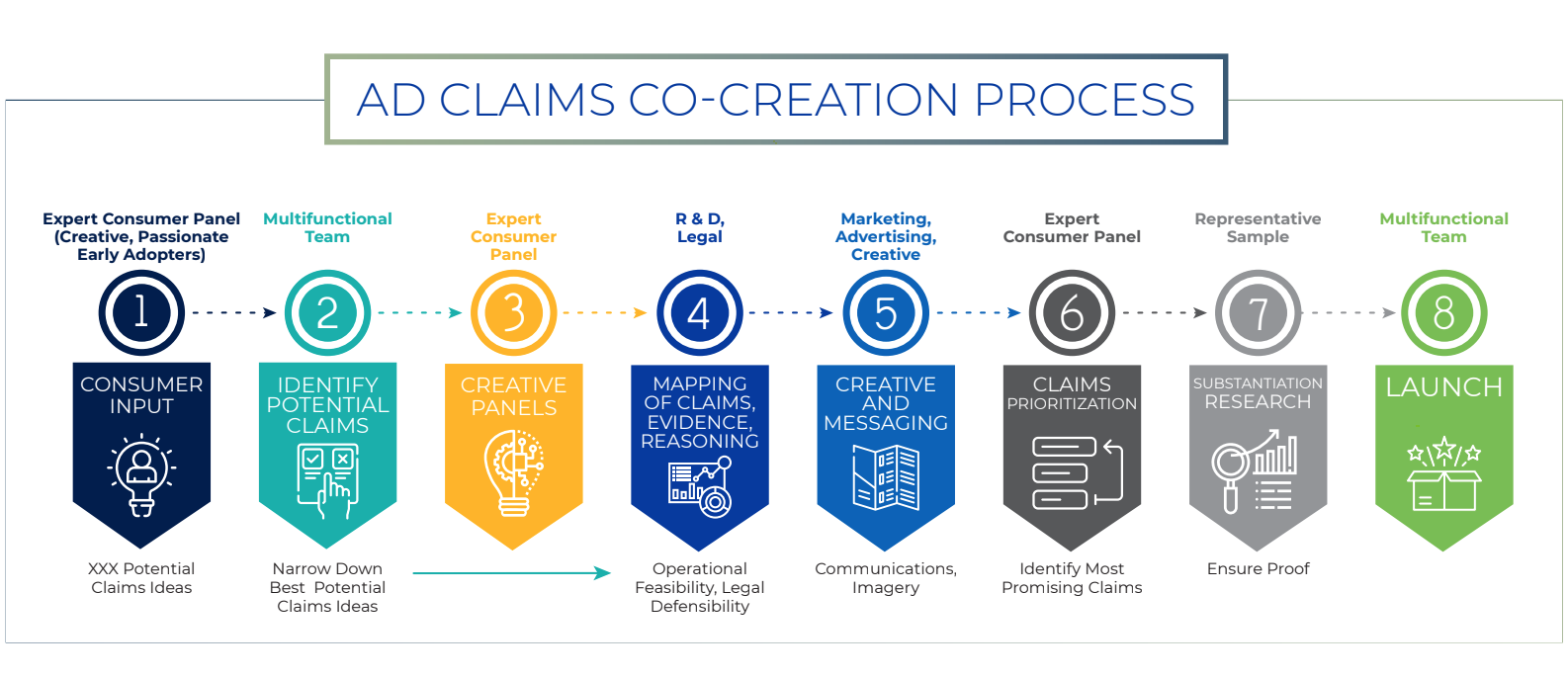8 Steps to Bullet Proof Ad Claims:
The Ad Claims Co-Creation Process
Some where between marketing creativity and consumers, there lives a set of statutes, rules, and regulations
designed to protect the customer from the potentially “unscrupulous” marketer. Adhering to this legal
infrastructure can feel restricting to creative marketing types. None the less, adherence is necessary and
required. Why? To protect your brand from lawsuits which are expensive and worse, can cause irreparable
damage your business.
The process of identifying claims
involves many different parties, both internally and externally. Identifying claims for effective
advertising requires the collaboration and coordination of Brand Management, R&D, Consumer Insights,
Legal, and the Ad Agency or Creatives. Making sure everyone is on – and stays on – the same page is a
significant challenge.
Research America’s Ad Claims Co-Creation Process goes beyond brainstorming to establish a
strategy for a clear short-, medium-, and long-term action plan for implementing advertising claims for a
brand or product. The process applies equally to new products (innovation), product development, and brand
extensions. Fundamentally, the process encourages the collaboration of all of the involved in claims
creation, including, most importantly, the consumer, to identify and evaluate potential advertising claims.
8 Steps to Bullet Proof Claims
Step 1: Consumer Input: We recruited 40 “expert consumers.” These were adult RTD coffee
drinkers who were very creative and passionate about participating in the co-creation process. Our first
evaluation was qualitative: three discussion groups and a taste test comparing our client’s brand to other
national and regional brand products. In this step, we wanted to generate a wide variety of potential claims
that were particularly important to consumers in choosing RTD coffee. All of the claims team members observed
the qualitative research.
Step 2: Identify Potential Claims Quantitative research follows a defined process, especially in data
collection. Surveys are programmed to allow the presentation of questions and stimuli in a specific order,
whereas qualitative research can adapt to the information that is being gathered. If one approach is
ineffective, a good qualitative researcher can immediately shift gears and seek to explore data in a new
direction. If the researcher hears a promising thought, they can easily and quickly incorporate it into the
discussion.
Step 3: Creative Panels Next, we brought the “expert consumer panel” into an online
discussion to rank and evaluate, provide feedback on opportunities for improvement for potential claims
identified by the team. After receiving the results, the entire team further narrowed down the list to the most
potentially effective – and provable – claims.
Step 4: Mapping of Claims, Evidence, and Reasoning For each of the remaining claims, Legal and
R&D had to evaluate the potential feasibility. Is it operationally possible for our client’s brand to credibly
make this claim? Can we develop substantiation data that could protect us from competitive and legal challenges?
Finally, a few claims made the cut.
Step 5: Creative and Messaging Brand Marketing, the Ad Agency, and Creatives then went to work
to express the operational and defensible claims in a marketing campaign. Effectively communicating the product
superiority claim and enticing product trial were the advertising goals.
Step 6: Prioritize Claims Once again, our client used their “expert consumer panel” to evaluate
the advertising. The team selected the ad identified as most persuasive and credible for implementation.
Step 7: Substantiation Research Finally, we selected a nationally representative sample of
adult category users (n=600) to evaluate the product in a blind taste test asking the right questions to support
the claims that were of interest: blindly, which product do you prefer? How likely are you to buy this product?
This research was able to provide the evidence needed to validate the leading claims: is our product better as
claimed? Can we defend ourselves should our competitors object?
.
Step 8: Launch The advertising campaign went live, and the results were monitored for
effectiveness.

Watch out for the next blog to hear about the Ad Claims Co-Creation Process in action!
"Can our Ad Claims Co-Creation Process help your brand? Contact Research America today! "


